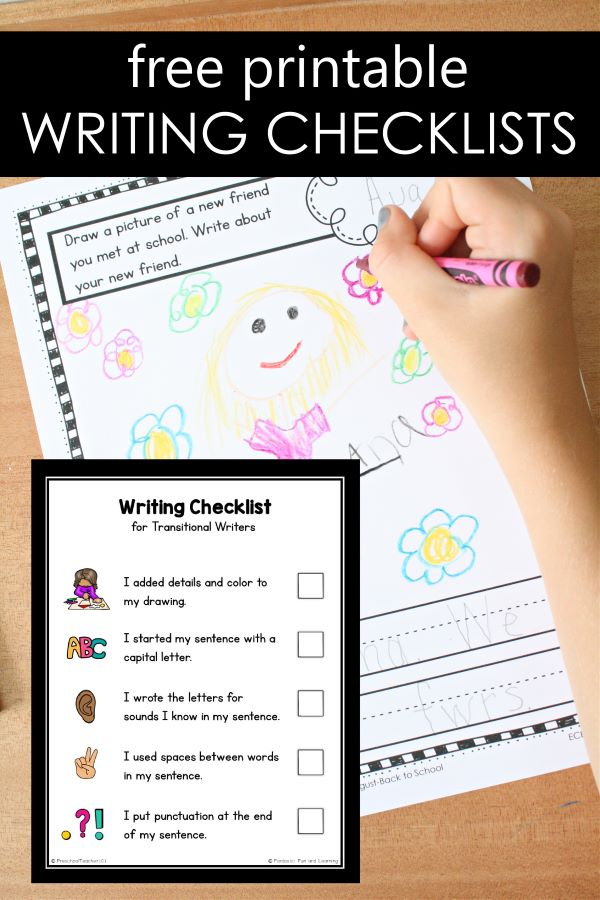Use these free printable writing checklists in prekindergarten, kindergarten and first grade to match writing skills for various developmental stages of writing development.
Yes, preschoolers can write! It looks a bit different than an older child’s writing, but writing instruction can and should begin even in pre-k classes.
It’s important to remember that there is a difference between learning to write letters (handwriting) and learning to write.
Letter formation and handwriting develop as part fine motor skill development.
Learning to write has more to do with learning to share ideas in pictures and words and then in learning to record these ideas by applying phonics skills.
But the key first step is teaching young authors that their ideas can be put into print, first through pictures and then through writing.
Initially we do this by discussing writing prompts together and inviting children to elaborate orally about their ideas.
Then we model recording those ideas with pictures.
As students are ready they can begin to share their own pictures and ideas.
I share more about how we introduce writing in this article about teaching writing in using regular writing prompts.
Today’s free printable writing checklists will help beginning writers learn to evaluate their writing. They can be used in whole group for shared and modeled writing experiences and after independent writing tasks as students are ready.

Differentiated Writing Checklists for Developmental Writing Stages
As children are focusing on different skills during each developmental stage of writing, we’ve created different checklists for each stage.
Here is a very brief overview of the writing stages we’ve included in our checklists.
EMERGENT WRITERS (PreK-K)
In this stage of writing children progress from making strings of random letters to grouping random letters. Then later in this stage writers will begin to match pictures to their ideas and start to add beginning sounds to label their pictures.
The checklist for this stage focuses on:
- generating ideas,
- using detail in pictures, and
- labeling elements in the picture with beginning sounds.
We’ve also included an opportunity for young authors to articulate the idea behind their writing, as often they are able to elaborate much more verbally than they can do in writing at this stage. It is important for them to learn to and have the opportunity to create detailed pictures and verbally share rich descriptions so that these details are later present in their text descriptions as they move on to the next stages of writing development.
TRANSITIONAL WRITERS (K-1)
Transitional writers progress from phonetically using beginning sounds to using final and then medial sounds. There are also attempts at spacing words and spelling some common words.
FLUENT WRITERS (K-2)
In general students in this phase progress from writing phrases to sentences and then on to multiple sentences and beyond. The use of known words, punctuation, and a clear topic focus is part of this stage.

Get the free printable Writing Checklists
Complete the form below and click “Send me the printable!” to get the free download.
GET OVER 300+ WRITING PROMPTS TO USE WITH THESE WRITING CHECKLISTS
Get kids writing often with regular journal writing prompts. This 800+ page writing journal BUNDLE includes simple writing prompts on a wide variety of topics with different purposes for writing for the ENTIRE YEAR. Kids will grow in their writing abilities and confidence in them through consistent opportunities to write.
Because we know kids are at all different stages in the writing process each writing prompt set includes both unlined and lined journal response pages.
If you already have pre-made journals use the mini prompts and glue them directly into your existing journals.
All Writing Journal Prompt Sets Include:
1) Tips for and a quick overview of Writer’s Workshop
2) Multiple Journal Cover Page Options
3) Journal Pages with Writing Prompt Idea (with lines and without lines)
4) Extended Page with Lines (for advanced writers)
5) Mini Journal Prompts (to be cut and glued into notebooks or writing journals)


Leave a Reply